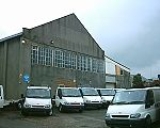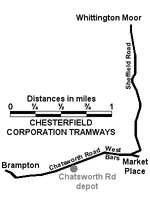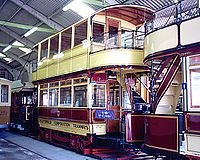
Chesterfield Tramway
Encyclopedia
The Chesterfield and District Tramways Company was a tram
way system in the Derbyshire
town of Chesterfield
.
The company was formed in 1879 and began operations in 1882. Due to not achieving a measure of solvency, the company took on debts of £500 and went into liquidation.
The Chesterfield Tramways Company took over in December 1886. The company brought several more tramcars and reduced the fare prices from 2d to 1d. Chesterfield Tramways decided to relay the track and extend the line to the borough boundaries and electrify it. The Electric Tramways Committee put forward a parliamentary bill to that effect.
 Work began in summer 1904 on the track relaying and hanging of the wire. The longer line was mostly single track with turnouts and double track in the town centre and opened in November 1904. Weekends proved to be rather busy so the line was operated in two sections with facing crossovers on Low Pavement and Cavendish Street to allow two tramcars to park side-by-side.
Work began in summer 1904 on the track relaying and hanging of the wire. The longer line was mostly single track with turnouts and double track in the town centre and opened in November 1904. Weekends proved to be rather busy so the line was operated in two sections with facing crossovers on Low Pavement and Cavendish Street to allow two tramcars to park side-by-side.
The company operated rather efficiently in its early years which allowed it to buy several more tramcars.
 Due to the condition of the tracks, the company kept it in condition by patching it. The Tramways Committee decided to transfer operations to trolley and motor buses in 1924. Brampton to Market Place closed in 1927, and Whittington Moor to Cavendish on 23 May 1927.
Due to the condition of the tracks, the company kept it in condition by patching it. The Tramways Committee decided to transfer operations to trolley and motor buses in 1924. Brampton to Market Place closed in 1927, and Whittington Moor to Cavendish on 23 May 1927.
The trolleybuses ran from Whittington Moor to Old Brampton
for 11 years and were replaced by motor buses.
, via Chesterfield
town centre
. In the town centre, a small spur
on Market Place existed, and closed in 1923.
The electric line opened in stages from 20 December 1904 to the end of January 1905.

Tramcars 6, 7, 8, 11 & 12 were top-covered in 1919.
Tramcar n°7 was transferred to the National Tramway Museum
in 1973 after spending some time at Two Dales. The car was restored between 1993 and 1996 at a cost of £120,000. The car now in its original condition and regularly runs on the mile long line at Crich
.
Tram
A tram is a passenger rail vehicle which runs on tracks along public urban streets and also sometimes on separate rights of way. It may also run between cities and/or towns , and/or partially grade separated even in the cities...
way system in the Derbyshire
Derbyshire
Derbyshire is a county in the East Midlands of England. A substantial portion of the Peak District National Park lies within Derbyshire. The northern part of Derbyshire overlaps with the Pennines, a famous chain of hills and mountains. The county contains within its boundary of approx...
town of Chesterfield
Chesterfield
Chesterfield is a market town and a borough of Derbyshire, England. It lies north of Derby, on a confluence of the rivers Rother and Hipper. Its population is 70,260 , making it Derbyshire's largest town...
.
The company was formed in 1879 and began operations in 1882. Due to not achieving a measure of solvency, the company took on debts of £500 and went into liquidation.
The Chesterfield Tramways Company took over in December 1886. The company brought several more tramcars and reduced the fare prices from 2d to 1d. Chesterfield Tramways decided to relay the track and extend the line to the borough boundaries and electrify it. The Electric Tramways Committee put forward a parliamentary bill to that effect.

The company operated rather efficiently in its early years which allowed it to buy several more tramcars.

The trolleybuses ran from Whittington Moor to Old Brampton
Old Brampton
Old Brampton is a village in Derbyshire, England. It lies 3 miles to the west of Chesterfield, on a spur of higher land between two small valleys. The Peak District National Park lies about 2 miles to the west.-In Culture:...
for 11 years and were replaced by motor buses.
The network
The tramway company operated a 3⅝ mile (5.8 km) long line, extended in 1904 from the original 1¼ mile (2 km) long line. The extended line ran from Whittington Moor to Old BramptonOld Brampton
Old Brampton is a village in Derbyshire, England. It lies 3 miles to the west of Chesterfield, on a spur of higher land between two small valleys. The Peak District National Park lies about 2 miles to the west.-In Culture:...
, via Chesterfield
Chesterfield
Chesterfield is a market town and a borough of Derbyshire, England. It lies north of Derby, on a confluence of the rivers Rother and Hipper. Its population is 70,260 , making it Derbyshire's largest town...
town centre
Town centre
The town centre is the term used to refer to the commercial or geographical centre or core area of a town.Town centres are traditionally associated with shopping or retail. They are also the centre of communications with major public transport hubs such as train or bus stations...
. In the town centre, a small spur
Spur (disambiguation)
A spur is a metal instrument fastened to the heel of a horse rider.Spur may also refer to:*Features of plants, animals, and humans, including:...
on Market Place existed, and closed in 1923.
The electric line opened in stages from 20 December 1904 to the end of January 1905.
Rolling stock
The tramway ran a plethora of tramcars.
- 12 'Aston' type Brush built open-top tramcars. Seating 22 passengers in the lower saloon and 34 on the top deck. The cars were 26 ft (7.924m) long and possessed an 8 ft 6in (2.59m) wheelbase, and were powered by 25 hp Westinghouse motors.
- 2 —1907 double-deck tramcars with flexible axle trucks also possessing an 8 ft 6in (2.59m) wheelbase. They were numbered 12 & 13.
- 1 —1909 water car. The car was numbered 15.
- 3 —1914 tramcars. These were Brush cars, numbered 16, 17 & 18. They had top covers and ran on 8 ft 6in (2.59m) wheelbase P22 Pendulum trucks.
Tramcars 6, 7, 8, 11 & 12 were top-covered in 1919.
Tramcar n°7 was transferred to the National Tramway Museum
National Tramway Museum
The National Tramway Museum, at Crich, in Derbyshire, England, is situated within Crich Tramway Village, a period village containing a pub, cafe, old-style sweetshop, including the tram depots. The village is also home to the Eagle Press, a small museum dedicated to Letterpress Printing including...
in 1973 after spending some time at Two Dales. The car was restored between 1993 and 1996 at a cost of £120,000. The car now in its original condition and regularly runs on the mile long line at Crich
Crich
Crich is a village in Derbyshire in England. It has the National Tramway Museum inside the Crich Tramway Village, and at the summit of Crich Hill above, a Memorial Tower for those of the Sherwood Foresters regiment who died in battle, particularly in World War I.Built in 1923 on the site of an...
.

